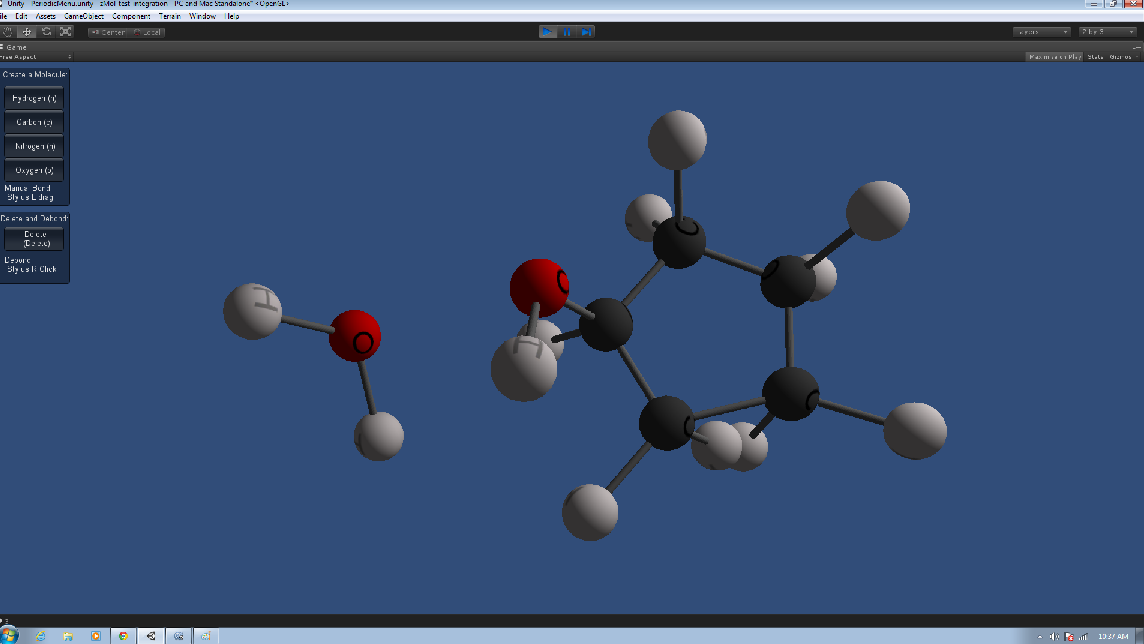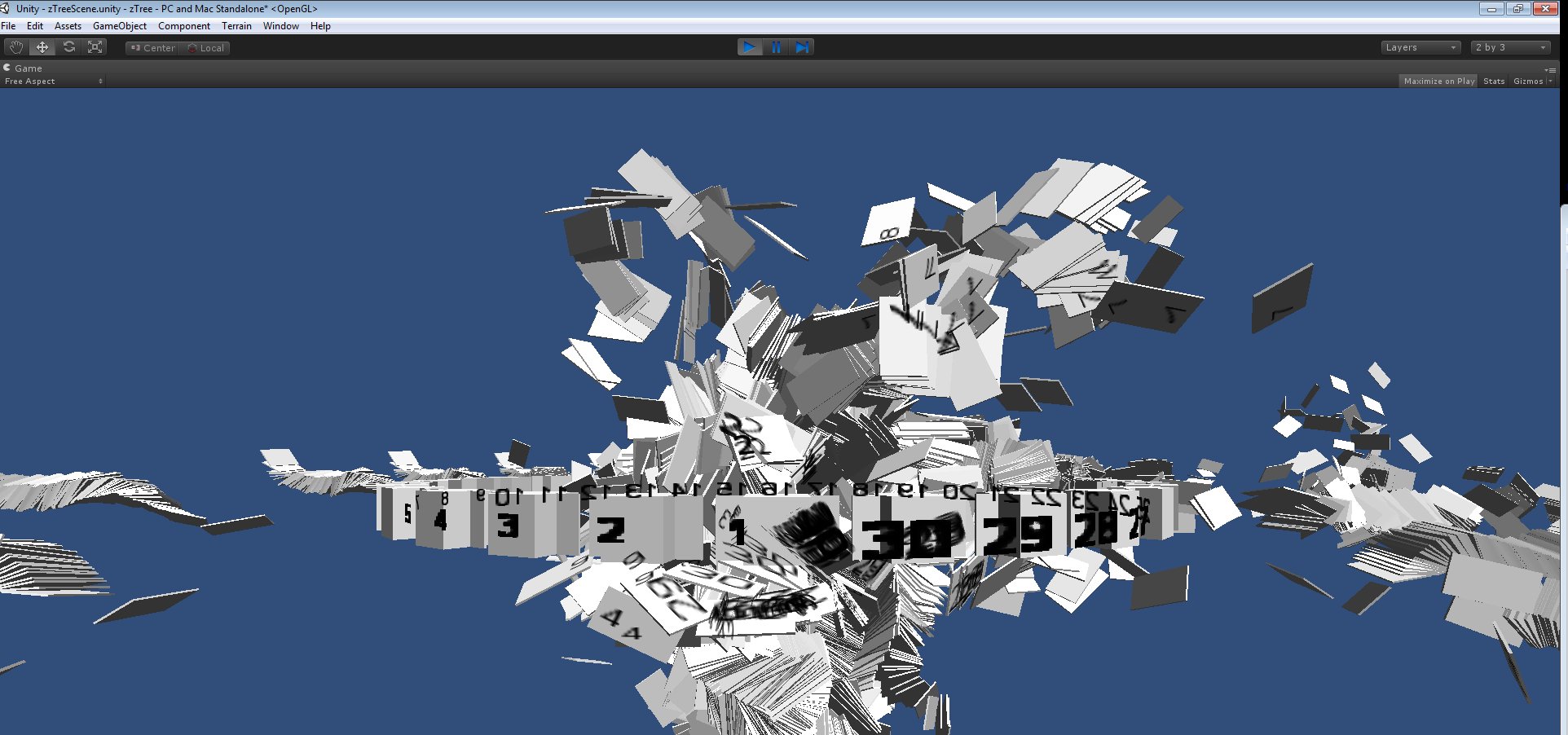Team:Wellesley Desyne/Notebook/CassieNotebook
From 2013.igem.org
| Line 170: | Line 170: | ||
==July 7== | ==July 7== | ||
Last week was the 4th of July! My brother and neighbor came to visit me so they occupied my week. We started working on our newest project, zTree. The idea behind zTree is to allow tree structured data to be represented in a 3D interactive way. We struggled a lot this week just to get the zSpace packages working in Unity.. and failed. After spending so much time on just that, Orit finally told us to give up on the zSpace aspects of the project for now, and just focus on functionality. We got cards to spawn in a carousel shape and the carousel spins around to allow users to select different cards. | Last week was the 4th of July! My brother and neighbor came to visit me so they occupied my week. We started working on our newest project, zTree. The idea behind zTree is to allow tree structured data to be represented in a 3D interactive way. We struggled a lot this week just to get the zSpace packages working in Unity.. and failed. After spending so much time on just that, Orit finally told us to give up on the zSpace aspects of the project for now, and just focus on functionality. We got cards to spawn in a carousel shape and the carousel spins around to allow users to select different cards. | ||
| + | |||
| + | ==July 14th== | ||
| + | Story of my life: | ||
| + | [[File:ExplosiveError1.png]] | ||
<!--Notebook ends here--> | <!--Notebook ends here--> | ||
Revision as of 13:35, 25 July 2013
Contents |
May 30
I’m only two weeks into my summer research and I feel like I’ve already learned so much! I started a week before everyone else, along with Dan, so we’ve had a bit of time to learn how to use the zSpace and Unity. For the record, zSpace is a machine that can turn a PC into a holographic computing system, which basically means that 3D objects in zSpace actually seem tangible. With the stylus, you can pick up and rotate object to see the entirety of them. Cameras on the machine interact with 3D glasses in order to track head movement and allow the user to see the objects in 3D. In order to make programs that will run on the zSpace, one needs a program that allows them to interact with 3D objects, so we’re working with Unity, a video game development tool.
Most of the first week was spent learning Unity and getting into the flow of working at Wellesley’s HCI Lab. We watched a few tutorial videos, looked through some code, and googled a lot of terminology. Our attempts to learn Unity were so that we could build on a program that was already started by previous HCI students. The program, zMol, intends to provide an interactive way to model the building of molecules without the many plastic pieces that students use now.
After a couple of days we felt more comfortable and started trying to make the buttons on the screen of the program interactive with the zSpace stylus. We made them bigger in the GUI so that the user would have an easier time selecting them, but ultimately we were advised that our efforts were best spent elsewhere so we moved on to trying to make the atoms have double bonding capabilities.
Memorial Day weekend gave us plenty of time go to clear our minds, enjoy the nice weather, and catch up on reading. I started learning a little bit of Blender to see if understanding the tools will help with making things in Unity. I haven’t gotten very far but I’ll keep working at it. In addition to work, I spent some time in Boston running errands and spending time with friends.
Tuesday and Wednesday Daniel and I worked on double bonding and finally got our bonds to change colors. As simple as it sounds, it was a victory for us since we just really working on this code. We also had a lot of meetings since all of the other HCI students were joining us for the first time and we had to help orient them to the lab.
Thursday we went to MIT to learn more about synthetic biology. Having no biology background and very little sleep, I was frustrated by the amount of times someone said, “Remember this from when you took biology?” The answer is no, I don’t, that was 6 or 7 years ago and I had a poorly taught bio class. Anyway, I learned as much as I could from that. I felt like there were very clear directions, but the directions really didn’t teach me anything as there was no explanation on why we did what we did. Even after taking CS240, the instructions on building the simulator with the breadboard were pretty annoying. They weren’t very clear or technological. It was okay though, I learned a bit about working in a wet lab and what the environment was nice and I temporarily got to play with fire so that was cool. Afterwards, we got smoothies and then ran to the bus which proceeded to be an hour late.
Friday was commencement so I had to be there working at it. The ceremony was interesting and Orit won the Pinanski Award! I came back to the lab at about 1:30 and found out what Dan had been working on. He’d figured out how to adjust the angles of the bonds after double bonding, so we worked together on deleting the old bonds. We discovered that there was an array that kept track of bonds, so if we iterated through the array and deleted the other bonds, then we could have the correct bonds remaining in the right places. This is what we need to continue working on on Wednesday when we return from BU.
Think about these for the future:
Here are some questions you might consider:
Who is your user?
What and where in the design cycle are the needs in synthetic biology?
During your wet lab experience, how did you feel? Were you ever overwhelmed? How might you mediate that?
What other domains and tools do you think you can refer to for your projects?
Where there gestures? Sketches? Interfaces that came to mind when you were trying to deal with the experiment protocol?
How could you frame synbio as a "good" thing?
Where and for what reason might a synbio-ist benefit from a
viz interface?
Hands-free interface
Multitouch
tangible
3D
June 6
This week we got a break from struggling with zMol and zSpace to go to BU and learn about their project. I had to try to understand biology to learn what their project was about, so that was an interesting learning experience. We had fun with them by having lunch and going bowling. While at Boston University, I did the Sifteo Cube study with Consuelo which I thought was the best part about my trip to BU. I really liked learning about her project and some of the other uses for Sifteo Cubes. Wednesday and Thursday we returned to working on zMol and double bonding at Wellesley. We're still struggling with understanding the old zMol spaghetti code. We got Kevin, one of the previous developers of zMol to come help explain the code to us and his thought process during their development. We've experimented with double bonding enough to get bonds to change colors but it's very glitchy and crashes a lot. We're starting to understand more things, bit by bit.
June 14
We've struggled with double bonding for several days with a bit of success, but there are still many glitches. We spent a few days just getting everything in working order to present our project to BU. We were joined this week by our intern, Yoav. We're getting into more of a rhythm with our work this week. We're supposed to start thinking about our 3D representation of the periodic table of elements so we spent some time drawing up designs for the program. We're hoping to make it easy and intuitive to use. We'd like it to be searchable, colorful, and to contain as many 3D things as possible. A goal of ours is to show information about each element in the 3D space instead of on a GUI and to have all the elements interact with zMol so we can accurately allow users to create covalent bonds. We presented to BU and they liked playing with the sample programs on the zSpace, but our program didn't seem to interest them much.
June 28
The last two weeks we've been under a lot of pressure to get things working in zMol. Orit decided that we should try to submit a poster presentation for UIST, which is a really prestigious conference in Scotland. We tried really hard to get as many features in as possible, but the haptic feedback wasn't working like we thought they should. We'd created a search function, double bonding was getting better and our program didn't crash nearly as much but it wasn't good enough without the haptics. We were a bit disappointed at not getting to submit the paper, but it's okay. With the help from Barton, or "the zSpace Guy", we tried to get both of the zSpaces we have compatible with each other and with the latest versions of the zSpace packages. We thought it went well and we had a new version of zMol up and running but we still have loads of problems with it. The haptics still don't work and zSpace's support is... non-existent. It's a bit frustrating that no matter how much work we put in, a lot of the problems fall with zSpace and we can't get any support to make it better. Hopefully zSpace will develop some support or get it together soon.
 Here's what the periodic table ultimately looks like.
Here's what the periodic table ultimately looks like.
 And here's the final version of zMol (for now)!
And here's the final version of zMol (for now)!
July 7
Last week was the 4th of July! My brother and neighbor came to visit me so they occupied my week. We started working on our newest project, zTree. The idea behind zTree is to allow tree structured data to be represented in a 3D interactive way. We struggled a lot this week just to get the zSpace packages working in Unity.. and failed. After spending so much time on just that, Orit finally told us to give up on the zSpace aspects of the project for now, and just focus on functionality. We got cards to spawn in a carousel shape and the carousel spins around to allow users to select different cards.
July 14th
 "
"

